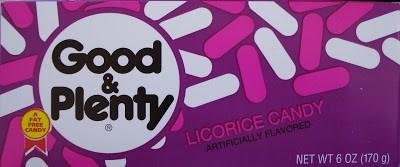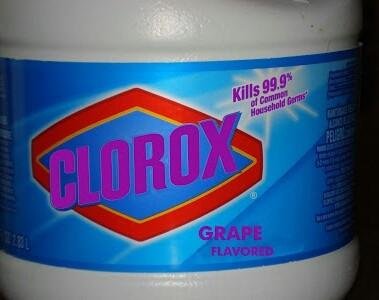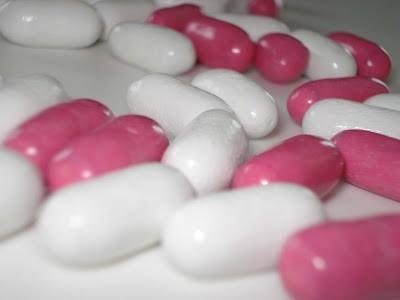
First Impressions: That's an attractive box.
Like everyone else alive today under the age of sixty, I thought Good and Plenty tasted like Robitussin. At best Robitussin.
At worst...I don't know, maybe bleach, or grape bleach. Something terrible. We all think they taste terrible. I thought it, you thought it, everyone thinks it.

That label is almost criminally deceptive
You might think that any candy for which expectations were so staggeringly low would inevitably end up being better than expected. However, this is not always the case.
As proof I offer Red Hots, a candy that I expect to be terrible and is actually much much worse. But we're not here to crucify Red Hots (yet, mark my words.) No, we're here to give Good and Plenty just the right amount of praise that it deserves.
Good and Plenty holds the honored title of "Oldest Branded Candy In The United States." What does the caveat "branded candy" mean exactly? I have no idea, but the point is that Good and Plenties are incredibly old. 116 years old to be exact. In 1893 the Quaker City Confectionery Company started to churn out these little purple and white things. I'm going to assume they did this entirely by accident.

"What the hell happened?"- Good and Plenty inventor responds to first batch of candy.
However, despite looking like Dr. Mario capsules, and due to the incredibly crappy candies that had existed up until that point, the sales came rolling in.
Over the next 100 years Good and Plenty surfed the waves of candy commerce, floating from one candy company to the next. Eventually, as so many independent American candies inevitably do, it was sucked into the gaping, boneless maw that is the Hersheys company. There it currently resides, presumably strapped into a suspended animation pod, having its life force slowly sucked out by the Hershey Overmind.
So what do Good and Plenties taste like? Licorice! And not fakey licorice, but pretty genuine licorice with a nice, refreshing anise flavor. The other major flavor is molasses, which complements the licorice perfectly, enhancing it in the beginning of each bite and then taking over at the end to give a thick, almost iron, molasses aftertaste. Definitely tastes better than grape bleach, at least good enough that I can't stop munching on them while I'm writing this review. So kudos Good and Plenty, kudos.
The texture is even more unexpected. Coming in I was thinking Jujubes or Mike N' Ikes. But the reality is more like a stale Twizzler covered in a slightly crunchy sugary shell. You bite down and, for just a second, it seems like there's absolutely no way you're ever going to be able to chew the damn thing. The candy is just too hard.
Then, just as suddenly, it gives a little in your mouth and starts to break down, and next thing you know its chewy like a Twizzler. Also like a Twizzler, it just disappears. 'When did I swallow that?" you think. But in your heart of hearts you know that you didn't swallow it at all, the Good and Plenty just vanished.
The specific taste and texture of the candy is as good as it was unexpected. But what really shines about Good and Plenty is the sense that your eating a part of history. Literally eating history, like each Good and Plenty was made in 1893 and left to dry until today. Good and Plenty just feel, look, and taste old. But as it turns out, that isn't a bad thing.
Is Good and Plenty my new favorite candy? No, not by a long shot. But will I still run from it like a frightened school girl when I see it in the store? No, also not by a long shot. Good and Plenty is a candy that you take when offered to you, usually by an impossibly old person, or possibly from a friend, who also got it from an impossibly old person.
And maybe, just maybe, on the rarest of occasions, you'll see Good and Plenty's on a store shelf, nod your head slowly and say, "You know, that sounds alright. That sounds Al-right."
Then you'll buy some Reeses Pieces.

